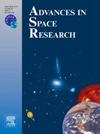An empirical model of the thermospheric winds based on ICON/MIGHTI observations
IF 2.8
3区 地球科学
Q2 ASTRONOMY & ASTROPHYSICS
引用次数: 0
Abstract
It is crucial to accurately reproduce the climatological features of the thermospheric neutral winds. We used the 2020–2022 data of the Michelson Interferometer for Global High-Resolution Thermospheric Imaging (MIGHTI) on the Ionospheric Connection Explorer (ICON) to develop an empirical model of thermospheric winds with the methods of the Non-Uniform Rational B-Spline and harmonic fittings (NURBS-Harmonic model). The NURBS-Harmonic model exhibits good adaptability for winds in every season with longitude, latitude, local time, and altitude. Over 70 % of the NURBS-Harmonic data are present with errors within 15 m/s, showing a better performance than the Horizontal Wind Model (HWM14). The percentage of HMW14 data errors within 15 m/s is about 40 %. The NURBS-Harmonic effectively captures the spatial structure of the wind fields and exhibits seasonal variations well. At 250 km, zonal winds in the low and middle latitudes at 12 LT exhibit a wavenumber-3 (WN3) structure in all the seasons, while they display a slight wavenumber-4 (WN4) longitude structure trend during June Solstice and September Equinox. Meridional winds at the same altitude show a distinct WN4 structure in every season. Different from the HWM14, which only includes migrating tides, the NURBS-Harmonic model also considers non-migrating tidal components. To validate the significance of non-migrating tides, we conducted a wave analysis on meridional winds at 250 km in September Equinox near the equator where non-migrating tides are relatively important. The analysis indicates that the amplitudes of the predominant non-migrating tidal components (SE2, DW2, and D0) are nearly equal and about 40 % of the dominant migrating tidal component DW1. This suggests that the non-migrating tidal components can contribute significantly to the overall wind field variability and should not be overlooked. In addition, the extensive height coverage from 91 km to 300 km of the MIGHTI data enables the model to provide precise altitude information. The zonal WN4 structure of zonal winds is most prominent in the altitude ranges of 100–250 km at low latitudes in the Northern Hemisphere during June Solstice and September Equinox. The model accurately reflects the phases variations of the winds at various altitudes. The phases of WN3 and WN4 at 110 km are opposite to those at 150 km, existing in all seasons. This may partially explain previous reports that the topside ionosphere equatorial vertical plasma drift is positively correlated with the zonal winds at 110 km and inversely correlated with those at 150 km.
基于ICON/MIGHTI观测的热层风经验模型
准确再现热层中性风的气候学特征至关重要。利用电离层连接探测器(ICON)上的全球高分辨率热层成像迈克尔孙干涉仪(Michelson Interferometer for Global High-Resolution Thermospheric Imaging, migighti) 2020-2022年数据,采用非均匀理性b样条和谐波拟合(NURBS-Harmonic model)方法建立了热层风的经验模型。NURBS-Harmonic模型对经度、纬度、当地时间和海拔各季节的风均具有良好的适应性。超过70%的NURBS-Harmonic数据误差在15 m/s以内,表现出比水平风模型(HWM14)更好的性能。HMW14在15m /s内的数据误差百分比约为40%。NURBS-Harmonic有效地捕捉了风场的空间结构,并很好地显示了季节变化。在250 km处,12 LT低纬度和中纬度纬向风四季均呈现波数-3 (WN3)结构,而在6至和9月春分时呈现轻微的波数-4 (WN4)经度结构趋势。同一高度经向风在各季节表现出明显的WN4结构。与HWM14只包括迁移潮不同,NURBS-Harmonic模型还考虑了非迁移潮分量。为了验证非迁移潮的重要性,我们对赤道附近的非迁移潮相对重要的9月分250公里的经向风进行了波浪分析。分析表明,主要非迁移潮汐分量(SE2、DW2和D0)的振幅基本相等,约占主要迁移潮汐分量DW1的40%。这表明非迁移潮汐分量对整体风场变率的贡献很大,不应忽视。此外,MIGHTI数据的广泛高度覆盖范围从91公里到300公里,使该模型能够提供精确的高度信息。纬向风的纬向WN4结构在北半球低纬度100-250 km高度范围内最为突出。该模型准确地反映了风在不同高度的相位变化。WN3和WN4在110 km处的相位与150 km处的相反,四季都存在。这可以部分解释以前的报道,电离层上层赤道垂直等离子体漂移与110 km处的纬向风正相关,而与150 km处的纬向风负相关。
本文章由计算机程序翻译,如有差异,请以英文原文为准。
求助全文
约1分钟内获得全文
求助全文
来源期刊

Advances in Space Research
地学天文-地球科学综合
CiteScore
5.20
自引率
11.50%
发文量
800
审稿时长
5.8 months
期刊介绍:
The COSPAR publication Advances in Space Research (ASR) is an open journal covering all areas of space research including: space studies of the Earth''s surface, meteorology, climate, the Earth-Moon system, planets and small bodies of the solar system, upper atmospheres, ionospheres and magnetospheres of the Earth and planets including reference atmospheres, space plasmas in the solar system, astrophysics from space, materials sciences in space, fundamental physics in space, space debris, space weather, Earth observations of space phenomena, etc.
NB: Please note that manuscripts related to life sciences as related to space are no more accepted for submission to Advances in Space Research. Such manuscripts should now be submitted to the new COSPAR Journal Life Sciences in Space Research (LSSR).
All submissions are reviewed by two scientists in the field. COSPAR is an interdisciplinary scientific organization concerned with the progress of space research on an international scale. Operating under the rules of ICSU, COSPAR ignores political considerations and considers all questions solely from the scientific viewpoint.
 求助内容:
求助内容: 应助结果提醒方式:
应助结果提醒方式:


